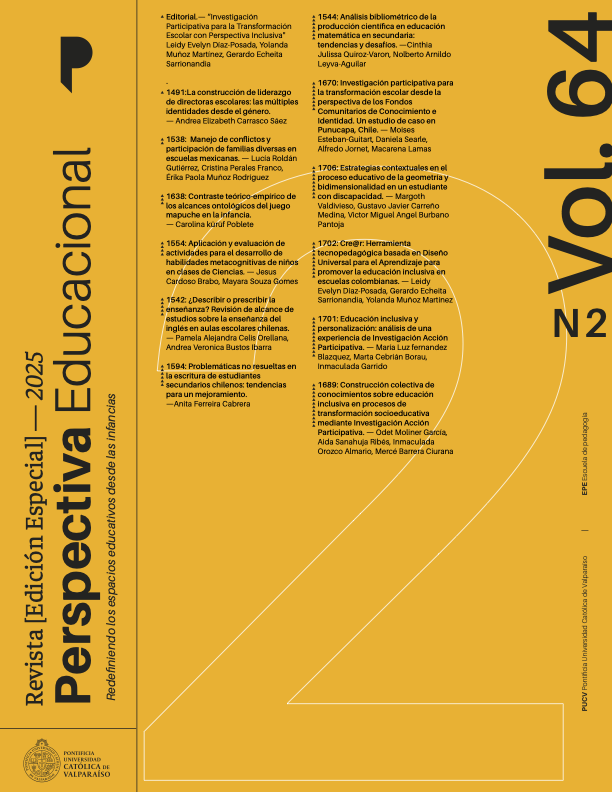Bibliometric Analysis of Scientific Production in Secondary Mathematics Education: Trends and Challenges
DOI:
https://doi.org/10.4151/07189729-Vol.64-Iss.2-Art.1544Keywords:
Mathematics Secondary education Educational technology Bibliometrics Problem SolvingAbstract
Mathematics education is essential for developing critical thinking and problem-solving skills in students, preparing them for an increasingly technological world. Over the past decade, research in this field has gained prominence, driven not only by the need for effective educational policies but also by the imperative for pedagogical innovation. This study conducts a bibliometric analysis of scientific production in secondary mathematics education, aiming to identify trends, influential authors, and emerging topics in global research. The primary objective is to analyze the evolution of scientific output in secondary mathematics education between 2013 and 2023, focusing on identifying research trends, prolific authors and countries, and emerging topics and challenges in the field.
The study employs a bibliometric design with a descriptive and retrospective approach. The Scopus database, recognized for its broad coverage of peer-reviewed scientific publications and citations, was utilized as the main data source. The bibliographic search took place in June 2024, encompassing publications from 2013 to 2023. Advanced techniques, including co-authorship network analysis and keyword co-occurrence analysis, were applied using tools such as R Studio, VOSviewer, and CiteSpace. These tools facilitated the statistical analysis and visualization of research trends. A total of 1,831 records were selected after applying specific inclusion and exclusion criteria, prioritizing scientific articles, book chapters, reviews, and complete books. The methodology also involved manual reviews to ensure data accuracy and consistency.
The analysis revealed a substantial increase in the production of scientific articles on secondary mathematics education, growing from 114 articles in 2013 to 257 in 2023, reflecting a 125.44% increase. The United States led in production with 365 articles and an h-index of 33, followed by Spain and Australia, demonstrating a relevant impact on research. Additionally, 529 authors were identified, organized into seven main research clusters, focusing on areas such as mathematics pedagogy, digital technology integration, and STEM education.
Moreover, the keyword analysis showed a trend toward pedagogical innovation, emphasizing advanced educational technologies and curriculum adaptation to 21st-century demands. The most frequent keywords included "Mathematics Education," "Mathematics," and "Secondary Education," indicating a sustained interest in improving mathematics teaching. International collaborations also played a significant role, facilitating knowledge exchange and supporting the implementation of innovative educational practices across different regions.
In conclusion, the study demonstrates that secondary mathematics education is a growing field with a positive trend in scientific production and robust international collaboration. The findings highlight the need to align educational practices with evolving technological and methodological demands, offering a solid foundation for future research and educational policy development. The study recommends promoting international collaboration to share best practices, integrate emerging educational technologies, and ensure equitable access to educational opportunities, particularly in under-resourced regions. This research provides valuable insights into current and emerging trends in mathematics education, supporting continuous innovation and improvement in teaching practices at a global level.
References
Acevedo, I., Castellani, F., Cota, M. J., Lotti, G., & Székely, M. (2024). Higher inequality in Latin America: A collateral effect of the pandemic. International Review of Applied Economics, 38(3), 280-304. https://doi.org/10.1080/02692171.2023.2200993
Ahmad, N. I. N., & Junaini, S. N. (2020). Augmented Reality for Learning Mathematics: A Systematic Literature Review. International Journal of Emerging Technologies in Learning, 15(16), 106-122. https://doi.org/10.3991/ijet.v15i16.14961
Arisoy, B., & Aybek, B. (2021). The effects of subject-based critical thinking education in mathematics on students’ critical thinking skills and virtues. Eurasian Journal of Educational Research, (92), 99-120. https://doi.org/10.14689/EJER.2021.92.6
Barana, A., Pulvirenti, M., Fissore, C., & Marchisio, M. (2020). An online math path to foster the transition of students between lower and upper secondary school. En Proceedings of the 16th International Scientific Conference eLearning and Software for Education, (1). 568-575. https://doi.org/10.12753/2066-026X-20-074
Bertoni, E., Elacqua, G., Marotta, L., Martínez, M., Santos, H., & Soares, S. (2023). Is school funding unequal in latin america? A cross-country analysis of interregional disparities in public spending. Comparative Education Review, 67(1), 100-122. https://doi.org/10.1086/722831
Bilgili, H., & Sheu, C. (2022). A Bibliometric Review of the Mathematics Journal. Mathematics 10(15), 2701. https://doi.org/10.3390/math10152701
Bosica, J., Pyper, J. S., & MacGregor, S. (2021). Incorporating problem-based learning in a secondary school mathematics preservice teacher education course. Teaching and Teacher Education, 102. Artículo 103335 https://doi.org/10.1016/j.tate.2021.103335
Burgess, S., Hauberg, D. S., Rangvid, B. S., & Sievertsen, H. H. (2022). The importance of external assessments: High school math and gender gaps in STEM degrees. Economics of Education Review, 88. https://doi.org/10.1016/J.ECONEDUREV.2022.102267
Casinillo, L., Camulte, M. C., Raagas, D., & Riña, T. S. (2020). Cultural factors in Learning Mathematics: The Case on Achievement Level Among Badjao Students. International Journal of Indonesian Education and Teaching, 4(1), 71-81. https://doi.org/10.24071/ijiet.v4i1.2345
De Santana, A. N., Roazzi, A., & Nobre, A. P. M. C. (2022). The relationship between cognitive flexibility and mathematical performance in children: A meta-analysis. Trends in neuroscience and education, 28, Artículo 100179. https://doi.org/10.1016/J.TINE.2022.100179
Deieso, D., & Fraser, B. J. (2019). Learning environment, attitudes and anxiety across the transition from primary to secondary school mathematics. Learning Environments Research, 22(1), 133-152. https://doi.org/10.1007/S10984-018-9261-5
Domínguez-González, R., & Delgado-Martín, L. (2022). Arousing Early Strategic Thinking about SDGs with Real Mathematics Problems. Mathematics, 10(9), 1446. https://doi.org/10.3390/MATH10091446
Eli, J. A., McGraw, R. H., Anhalt, C. O., & Civil, M. (2019). Stronger Together: The Arizona Mathematics Teaching (MaTh) Noyce Program’s Collaborative Model for Secondary Teacher Preparation. In Recruiting, Preparing, and Retaining STEM Teachers for a Global Generation. Leiden, The Netherlands: Brill. 36-57. https://doi.org/10.1163/9789004399990_002
Gómez Moreno, F. (2019). The Development of Mathematical competences in the educational institution Pedro Vicente Abadia of Guacari, Colombia. Revista Universidad y Sociedad, 10(6), 162-171. https://orcid.org/0000-0002-1360-4546
Hanus, M., Havelková, L., & šVubová, K. (2021). Math-Related Difficulties in Thematic Map Use in Lower Secondary Education. Review of International Geographical Education Online, 11(3), 735-759. https://doi.org/10.33403/RIGEO.851190
Instituto Nacional de Evaluación Educativa. (2024, noviembre). PISA 2022. Ministerio de Educación Formación Profesional y Deportes. Gobierno de España. https://www.educacionyfp.gob.es/inee/evaluaciones-internacionales/pisa/pisa-2022.html
Kaur, T., McLoughlin, E., & Grimes, P. (2022). Mathematics and science across the transition from primary to secondary school: A systematic literature review. International Journal of STEM Education 9(1), 1-23. https://doi.org/10.1186/S40594-022-00328-0
Kaymak, S., Bagzhan, M., & Yıldız, F. (2023). A Bibliometric Review on Realistic Mathematics Education Database Between 2000-2022. International Educational Review, 1(1), 25-39. https://doi.org/10.58693/ier.112
Klee, H. L., & Miller, A. D. (2019). Moving Up! Or Down? Mathematics Anxiety in the Transition from Elementary School to Junior High. The Journal of Early Adolescence, 39(9), 1311-1336. https://doi.org/10.1177/0272431618825358
Lannin, J. K., Rodrigues, J., van Garderen, D., Lei, Q., Singell, E. L., & Karim, S. (2023). Promoting Interdisciplinary Research Collaboration among Mathematics and Special Education Researchers. Education Sciences, 13(11), 1150. https://doi.org/10.3390/educsci13111150
Le Roux, K., & Swanson, D. (2021). Toward a reflexive mathematics education within local and global relations: thinking from critical scholarship on mathematics education within the sociopolitical, global citizenship education and decoloniality. Research in Mathematics Education, 23(3), 323-337. https://doi.org/10.1080/14794802.2021.1993978
Lim, Y. W., Darmesah, G., Pang, N. T. P., & Ho, C. M. (2023). A bibliometric analysis of the structural equation modeling in mathematics education. Eurasia Journal of Mathematics, Science and Technology Education. 19(12). https://doi.org/10.29333/ejmste/13838
Marchisio, M., Barana, A., Conte, A., Fissore, C., Floris, F., Brancaccio, A., & Pardini, C. (2019). The role of an advanced computing environment in teaching and learning mathematics through problem posing and solving. Proceedings of the 15th International Scientific Conference eLearning and Software for Education, (2), 11-18, https://doi.org/10.12753/2066-026X-19-070
Meeran, S., & Van Wyk, M. M. (2022). Mathematics teachers perceptions of socio-cultural diversities in the classroom. Journal of Pedagogical Research, 6(3), 72-87. https://doi.org/10.33902/jpr.202215441
Organización de las Naciones Unidas para la Educación, la Ciencia y la Cultura. (2023, 20 de abril). Las Matemáticas, enseñanza e investigación para enfrentar los desafíos de estos tiempos. Unesco. https://www.unesco.org/es/articles/las-matematicas-ensenanza-e-investigacion-para-enfrentar-los-desafios-de-estos-tiempos
Organización para la Cooperación y el Desarrollo Económico. (2023). Marco de evaluación y análisis de PISA 2022. https://doi.org/10.1787/DFE0BF9C-EN
Oxhorn, P., & Jouve-Martín, J. R. (2017). Inequality and inclusion in Latin America. In Latin American Research Review, 52(2), 203-207. https://doi.org/10.25222/larr.62
Pamungkas, M. D., Waluya, S. B., Mariani, S., & Isnarto. (2023). A Systematic Review of Complex Problem-Solving in Education and Mathematics Education. Journal of Higher Education Theory and Practice, 23(16), 87-101. https://doi.org/10.33423/jhetp.v23i16.6465
Rahayuningsih, S., Sirajuddin, S., & Nasrun, N. (2020). Cognitive flexibility: Exploring students’ problem-solving in elementary school mathematics learning. Journal of Research and Advances in Mathematics Education, 6(1), 59-70. https://doi.org/10.23917/jramathedu.v6i1.11630
Ridho, M. H., Muhammad, I., & Mulyaning, E. C. (2023). Mathematical Identity in Learning Mathematics: Bibliometric Review. Studies in Learning and Teaching, 4(3), 551-565. https://doi.org/10.46627/silet.v4i3.287
Rodríguez-Muñiz, L. J., & Díaz, P. (2015). Estrategias de las universidades españolas para mejorar el rendimiento en matemáticas del alumnado de nuevo ingreso. Aula Abierta, 43(2), 69-76. https://doi.org/10.1016/J.AULA.2015.01.002
Ryan, V., Fitzmaurice, O., & O’Donoghue, J. (2022). Student Interest and Engagement in Mathematics After the First Year of Secondary Education. European Journal of Science and Mathematics Education, 10(4), 436-454. https://doi.org/10.30935/SCIMATH/12180
Smirnov, E. I., Zykova, T. V., & Tikhomirov, S. A. (2019). Managing of mathematics education with synergistic effects. Espacios, 40(9). https://www.revistaespacios.com/a19v40n09/19400925.html
Treacy, P., O’Meara, N., & Prendergast, M. (2023). The role of expectancy-value theory in upper-secondary level students’ decisions to avoid the study of advanced mathematics. Irish Educational Studies. 43(4), 1175-1188. https://doi.org/10.1080/03323315.2023.2200420
Vanderburg, R. (2024). Enhancing Mathematical Proficiency through Digitally Individualized Pedagogy. Pacific Journal of Technology Enhanced Learning, 6(1), 29. https://doi.org/10.24135/pjtel.v6i1.200
Vásquez, C., Alsina, Á., Seckel, M. J., & García-Alonso, I. (2023). Integrating sustainability in mathematics education and statistics education: A systematic review. Eurasia Journal of Mathematics, Science and Technology Education, 19(11). https://doi.org/10.29333/EJMSTE/13809
Wilkerson, T. L. (2022). 2022 Founder’s Lecture: Current Research Trends in Mathematics Learning that Guide Us for the Future. Investigations in Mathematics Learning, 14(4), 251-264. https://doi.org/10.1080/19477503.2022.2145079
Zandy, S. S., & Negara, H. R. P. (2024). Mathematical proficiency siswa pada materi persamaan garis lurus ditinjau dari resiliensi matematis. Journal of Didactic Mathematics, 5(1), 70-80. https://doi.org/10.34007/JDM.V5I1.2197
Downloads
Published
How to Cite
Issue
Section
License
Copyright (c) 1969 Cinthia Julissa Quiroz-Varon, Nolberto Arnildo Leyva-Aguilar

This work is licensed under a Creative Commons Attribution-ShareAlike 4.0 International License.
The authors grant an exclusive licence, without time limit, for the manuscript to be published in the Perspectiva Educacional journal, published by the Pontificia Universidad Católica of Valparaíso (Chile), through the School of Pedagogy.





